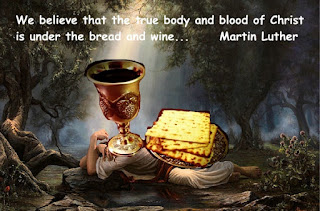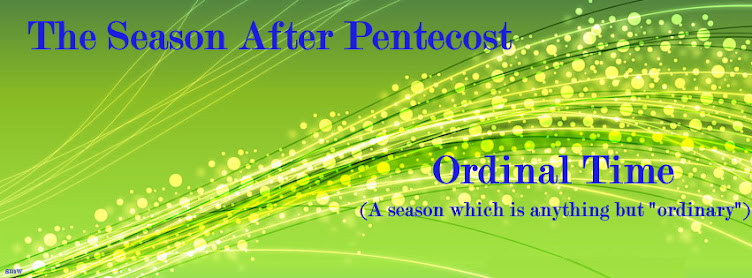The Catholic belief/faith in the Real Presence is that upon consecration of the bread and wine, while maintaining the appearance of bread and wine the substance changes to become the body and blood of Jesus Christ. There is no change in what we see or perceive through our senses, the accidents (in philosophical language) remain but the substance, that is what something REALLY is, changes so that what we receive through the Eucharist IS the body and blood of Christ. The scholastic or philosophical term for the Catholic position is "Transubstantiation" (trans = change and substantiation = substance, or a "change in substance"). For most Protestants they focus on "The Lord's Supper" as a memorial only - there is no change in the substance nor is there any special presence of Jesus Christ "in, on or under" (we'll get to that in a bit) with the bread or wine. For those it is pure symbolism.
Who, but the devil, has granted such license of wresting the words of the holy Scripture? Who ever read in the Scriptures, that my body is the same as the sign of my body? or, that is is the same as it signifies? What language in the world ever spoke so? It is only then the devil, that imposes upon us by these fanatical men. Not one of the Fathers of the Church, though so numerous, ever spoke as the Sacramentarians: not one of them ever said, It is only bread and wine; or, the body and blood of Christ is not there present.Note, while he insists upon the Real Presence, and even points to the unanimity of the Fathers of the Church, his language clings to Consubstantiation.
Surely, it is not credible, nor possible, since they often speak, and repeat their sentiments, that they should never (if they thought so) not so much as once, say, or let slip these words: It is bread only; or the body of Christ is not there, especially it being of great importance, that men should not be deceived. Certainly, in so many Fathers, and in so many writings, the negative might at least be found in one of them, had they thought the body and blood of Christ were not really present: but they are all of them unanimous.” [—Luther’s Collected Works, Wittenburg Edition, no. 7 p, 391; qtd on BFHU blog]
This next one, from Luther's Confession and the Lord's Supper, also shares a true belief in the Real Presence, but still a consubstantial understanding:
Christ has shown this to us not only by his own example and by his Word, but he has also pictured it to us in the form of the Sacrament of the Altar, namely, by means of the bread and the wine. We believe that the true body and blood of Christ is under the bread and wine, even as it is. Here we see one thing and believe another, which describes faith. For when we hear the Word and receive the Lord's Supper we have merely a word and an act, yet by it we embrace life and every treasure, even God himself. [Confession and the Lord's Supper, by Martin Luther]
 Much of that piece is Luther railing against the pope and Catholicism in general regarding the practice of not giving the Cup to the faithful, only the bread/body of Christ. That is another discussion though, so let us not be distracted by that discussion in discussing the subject of this article. Getting back to the subject, notice the statement that "the true body and blood of Christ is under the bread and wine." That is Consubstantiation. Again, it is very close to the Catholic belief of Transubstantiation, and if the true faith were stated, he could have/should have said something like "We believe that the bread and the wine IS the true body and blood of Christ," and then there would be no doubt and an affirmation of the, to use Luther's word "unanimous" consent of the Early Church Fathers.
Much of that piece is Luther railing against the pope and Catholicism in general regarding the practice of not giving the Cup to the faithful, only the bread/body of Christ. That is another discussion though, so let us not be distracted by that discussion in discussing the subject of this article. Getting back to the subject, notice the statement that "the true body and blood of Christ is under the bread and wine." That is Consubstantiation. Again, it is very close to the Catholic belief of Transubstantiation, and if the true faith were stated, he could have/should have said something like "We believe that the bread and the wine IS the true body and blood of Christ," and then there would be no doubt and an affirmation of the, to use Luther's word "unanimous" consent of the Early Church Fathers.In short, Luther's belief, which is perpetuated in today's Lutheran teaching, is one which accepts the Real Presence of Jesus Christ with the Eucharist. He brings you close, but not quite to what Jesus Christ Himself taught, and that is that "This IS My body" and "This IS My blood."
The scriptural TRUTH:






No comments:
Post a Comment
Keep in mind while posting:
1) Please respond ON TOPIC to the article at hand.
2) Posts more than 4 weeks old are set to automatically save new comments for moderation - so your comment may not show up immediately if you're responding to an older post.
3) The "Spam Filter" is on - and randomly messages get caught in that filter. I have no control over which messages get caught in the spam filter and those that do must wait for me to mark them as "not spam." A message caught by the spam filter may show up for a moment, making you think it posted, and then disappear. Do not assume I have deleted your comment, it's probably just the spam filter and it will show up.